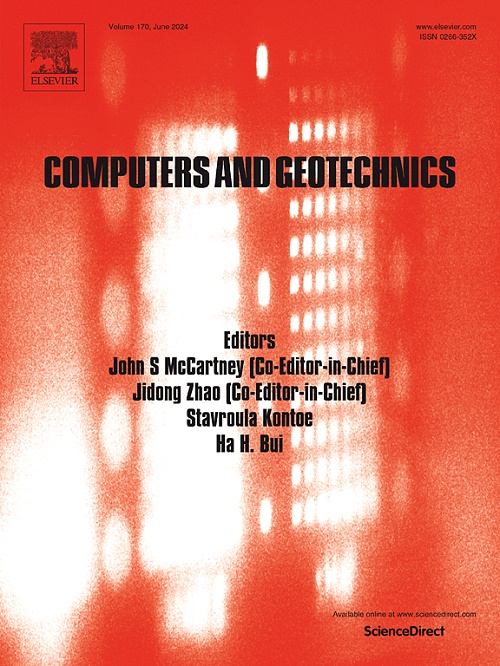结构土的应变功本构模型
IF 6.2
1区 工程技术
Q1 COMPUTER SCIENCE, INTERDISCIPLINARY APPLICATIONS
引用次数: 0
摘要
结构土的力学行为受颗粒间结合和结构排列的双重影响。现有的本构模型主要通过织物排列来解释土壤结构。在本研究中,我们首先进行了完整黄土样品的实验研究,包括各向同性压缩(IC)、常规不排水固结(CU)和排水固结(CD)三轴试验,揭示了土壤的复杂结构特性。接下来,我们利用应变能所做的工作来综合考虑土壤结构,包括颗粒间结合和织物排列。在此基础上,提出了结构土临界状态框架下的应变功本构模型。具体而言,引入应变功率与平均有效应力之间的线性递减函数来捕捉结构退化,并根据应变功与平均有效应力之间的关系推导出新的硬化规律。与传统的结构土模型相比,该模型物理意义清晰,参数易于获取。该模型的仿真结果与实验数据进行了验证,证明了其能够捕捉关键的力学和变形特性,例如CU条件下的应变软化和CD条件下的应变硬化。最后,将该模型与结构凸轮粘土(SCC)模型进行了比较,结果表明该模型与实验数据吻合较好,进一步验证了该模型的准确性和有效性。本文章由计算机程序翻译,如有差异,请以英文原文为准。

A strain work constitutive model for structured soils
The mechanical behavior of structured soils is influenced by both inter-particle bonding and fabric arrangements. Existing constitutive models primarily account for soil structure through fabric arrangements. In this study, we first present experimental investigations on intact loess samples, including isotropic compression (IC), conventional consolidation undrained (CU), and consolidation drained (CD) triaxial tests, which reveal the complex structural properties of the soil. Next, we employ the work done by strain energy to comprehensively account for soil structure, incorporating both inter-particle bonding and fabric arrangements. Subsequently, a new strain work constitutive model for structured soils is presented within the critical state framework. Specifically, a linear decreasing function between strain power and mean effective stress is introduced to capture structural degradation, and a new hardening rule is derived from the relationship between strain work and mean effective stress. Compared to traditional structured soil models, the proposed model offers clear physical meaning, and its parameters are easily obtainable. The model’s simulation results are validated against experimental data, demonstrating its ability to capture key mechanical and deformation characteristics, such as strain softening under CU conditions and strain hardening under CD conditions. Finally, we compare our model with the structured cam clay (SCC) model, and the results show that our model provides a better fit to the experimental data, further confirming its accuracy and effectiveness.
求助全文
通过发布文献求助,成功后即可免费获取论文全文。
去求助
来源期刊

Computers and Geotechnics
地学-地球科学综合
CiteScore
9.10
自引率
15.10%
发文量
438
审稿时长
45 days
期刊介绍:
The use of computers is firmly established in geotechnical engineering and continues to grow rapidly in both engineering practice and academe. The development of advanced numerical techniques and constitutive modeling, in conjunction with rapid developments in computer hardware, enables problems to be tackled that were unthinkable even a few years ago. Computers and Geotechnics provides an up-to-date reference for engineers and researchers engaged in computer aided analysis and research in geotechnical engineering. The journal is intended for an expeditious dissemination of advanced computer applications across a broad range of geotechnical topics. Contributions on advances in numerical algorithms, computer implementation of new constitutive models and probabilistic methods are especially encouraged.
 求助内容:
求助内容: 应助结果提醒方式:
应助结果提醒方式:


